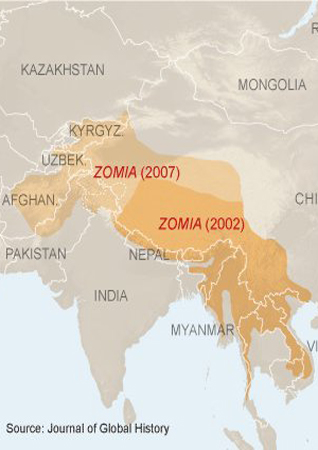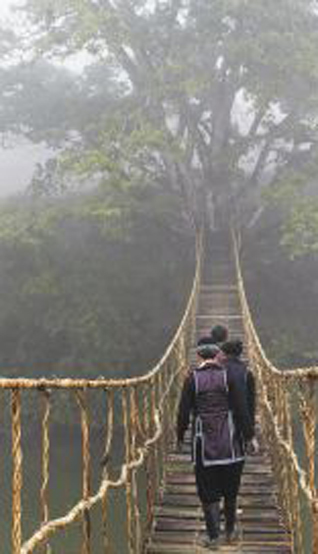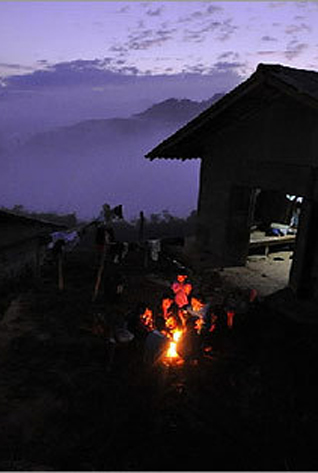Travel
Zomia:
An Undiscovered Country?
by FRANK JACOBS
A conventional border acts like a mirror - it’s the point where two identical, opposite institutional environments meet. The borderline both creates and separates a dual infrastructure: two border posts, two barriers painted in either side’s appropriate national colors, two sets of customs officers dressed in similar, semi-military uniforms, but owing allegiance to two different, faraway capitals.
What both sides have in common is the vaguely threatening aura that any border emits. Even the most peaceable of crossings has ominous overtones; it reminds us of their potential for violence and death in the way that purring kittens remind us of hungry lions. The frisson created by border crossings is an emotional Doppler effect: mounting anticipation, slowly easing on the other side.
Thus considered, a “classic” border is an isolated anomaly in the landscape, a hinge between two similar political realities.
But there exists another type of border, one that doesn’t reflect back our image. In vampiric asymmetry, it offers only the void.
There are no barriers, no officials, no capitals on the other side. The world as we know it — reciprocal even across national borders - ends here. One thinks of the American West in the mid-19th century, or parts of Brazil into the 20th. The borderline does not merely separate two territories, but two paradigms: law and order from anarchy, progress from primitivism. Or perhaps, seen from the other side: freedom from oppression, purity from decadence.
In earlier times, such lawless anomalies were surprisingly common, even in the middle of “civilization.” London was riddled by as many as a dozen legal safe havens, where debtors and criminals could seek refuge from arrest. Emerging first in the Middle Ages, they persisted until Parliament abolished the last of them in 1723.
Perhaps the most famous such zone was Alsatia, a small area west of Temple, between Fleet Street and the Thames, on the site of a former Whitefriars monastery.
The poet and playwright Thomas Shadwell, in his 1688 play “The Squire of Alsatia”, characterized the place as an unconquered affront to English rule: “Was ever such impudence suffer’d in a Government? Ireland‘s Conquer’d: Wales Subdu’d: Scotland United: But there are some few spots of ground in London, just in the face of the Government, unconquer’d yet, that hold in Rebellion still. Methinks ’tis strange, that places so near the Kings Palace should be no parts of his Dominions[.]”
Alsatia received its name in the early 17th century, after Alsace, the formerly German region on the Rhine’s left bank now part of France. It’s not clear why, but three interrelated possibilities come to mind: Because Alsace was even then hotly contested, between France and the Hapsburgs; because it had been left ravaged and lawless by the Thirty Years’ War; and because it - or at least a number of its cities - enjoyed a high degree of autonomy from its overlords, be they German or French.
The riotous, anti-authoritarian history of Alsatia has almost entirely disappeared from memory. One exception is as an obscure legal term. In 2007, Lord Justice Sedley criticized the establishment of a Serious Organized Crime Agency by claiming that “the state has set out to create an Alsatia - a region of executive action free of judicial oversight.”
Alsatia’s descent into obscurity is perhaps typical for areas outside of traditional power structures. They are eventually overrun by central authority, absorbed into the body politic and airbrushed out of history. But while such territories have largely disappeared, over the last decade a new, enormous Alsatia, of sorts, has been identified: Zomia, the highland areas of Southeast Asia that are outside traditional state control.
First identified in 2002 by the Dutch historian Willem van Schendel, Zomia originally included Tibet and other southwestern parts of China, northern and northeastern parts of India, most of Nepal and Myanmar, all of Bhutan and Laos, and bits of Thailand and Bangladesh. By proposing Zomia, Mr. Van Schendel highlighted a transnational area that is marginal to all the states that nominally control it. Few things unite it, except its diversity - religious, ethnic, cultural, linguistic - born of Zomia’s geographical character, dominated by the inaccessible Himalayan highlands and Tibetan plateau.
Zomia is a sanctuary, a refuge for isolated, unassimilated communities.
Mr. Van Schendel’s geographic construct might have been destined for the dustbin of hoary theory, but instead it took off: first among academic circles, then journalists, travelers and policy makers. In 2007, Mr. Van Schendel broadened the geographical scope of Zomia, extending it westward and northward to include large areas of Afghanistan, Pakistan, northern India (Kashmir), Tajikistan, Kyrgyzstan and eastern China (Xinjiang).
The western extension of Zomia brings into focus even more strikingly the rebellious, anticentralist, nature of much of this zone. Underpinned by Zomia’s physical geography, its human geography is authority-averse and continues to defy central governments - most violently in Afghanistan, but also in the tribal areas of Pakistan, in Indian-controlled Kashmir, in tribal-controlled areas in northern Myanmar and in Chinese-controlled Tibet. Other potential conflict zones within Zomia are the border disputes between India and China, and between India and Pakistan.
In 2009, the Yale political scientist James C. Scott examined the fractious nature of Zomia’s politics in a “counter-narrative” - in other words, from the local point of view. These highlanders, he contended, are not unassimilated because they are untouched by modernity, but because they reject it. This puts them in league with, or at least in the same league as, the non-conformists of Alsatia. This also illuminates, and complicates, our understanding of the Afghanistan-Pakistan conflicts, which might not be all about secular modernity versus religious orthodoxy, but maybe also about city versus village (or, more likely, valley).
Seen from this point of view, the city is winning: rapid urbanization is sucking ever more people to the lowland metropolises, further eroding the age-old tribal societies up in the mountains. Cellphone coverage has crept along the foothills of the both Himalayas and the Hindu Kush. In Tibet, new depths of desperation with the Chinese presence have recently led to a wave of self-immolation.
As with Alsatia, Zomia’s external border is inherently unstable. The borderline that separates law from lawlessness, or freedom from control, can’t remain fixed forever. It becomes more porous and permeable, and will eventually collapse. Which side will win? In Pakistan, it still seems like it could go either way.
But, for better or for worse, the tide of history seems turned against refuges, sanctuaries, freetowns, zones of no control. The skies over Pakistan are being patrolled by the harbingers of the new paradigm: zones of total control. Back in London, we’re witnessing the birth of the antisanctuary. The license plate of every vehicle entering the city center on weekdays is photographed, in order to levy a tax on traffic. Not only can the borders of that Congestion Charge Zone be extended and modified practically overnight, it also circumscribes an area of implicit resignation of privacy. Inside the CCZ, even pedestrians know they’ll be caught on camera more often than a struggling starlet in Hollywood.
Mentally, we’re already living in Jeremy Bentham’s panopticon: we are exercising self-control, because we might be watched. Who knows, soon borders - textbook ones and others - might be as antiquated and irrelevant as Alsatia and Zomia.
Frank Jacobs is a London-based author and blogger. He writes about cartography, but only the interesting bits.
[Courtesy: The New York Times]
February 15, 2012
Conversation about this article
1: Samuel Naulak (Oslo, Norway), November 23, 2012, 7:34 AM.
I like this website. I check it out everyday.






